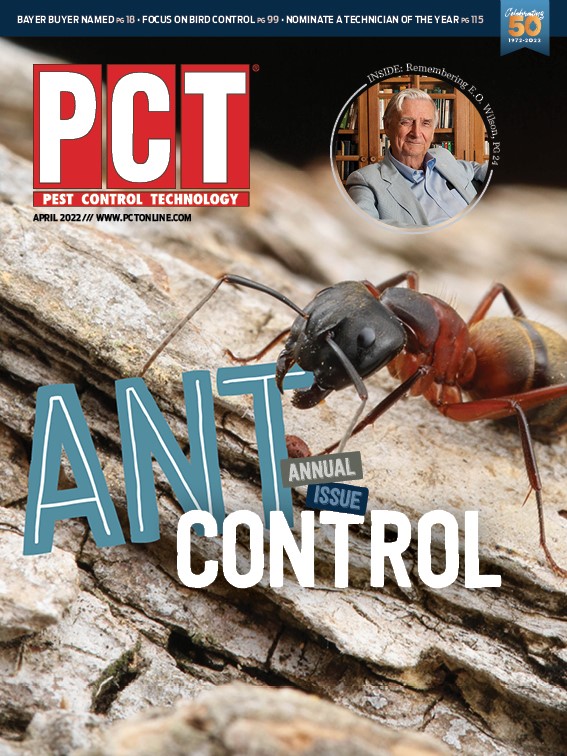Have you ever wondered what triggers a subterranean termite swarm and how colonies within an area synchronize their swarming to the same days?
While not every factor is understood, research has provided us with some ideas. Observation suggests that environmental factors are likely involved, and that a lot of questions remain unanswered.
THE STUDY. Research published in 2002 by Barry Furman and Dr. Roger Gold from Texas A&M University looked at native subterranean termite swarming in comparison with two environmental factors. Specifically, they examined the accumulation of degree days and precipitation in relation to termite swarming.
Information was collected for nine Texas cities over a six-year period. Degree days or heat units were determined by totaling the average temperature each day above a base temperature of 4°C, starting on Dec. 21 for each location. The occurrence and accumulation of rain also was tracked for each location.
Results of this study suggest that a minimum of 602 heat units after Dec. 21 had to be reached before a swarm could occur. There was a nearly two-month span from the swarm in the warmest areas to the coldest area in the study.
The accumulated amount of precipitation was not important in triggering swarming. What did matter is when the first rain occurred after the heat unit threshold was reached. In this study, about 90 percent of initial swarms occurred within three days of the first rain event after the minimum heat units were obtained.
THE TRIGGER. This research suggests that once enough warming occurs, termites wait for a rain event as a trigger to swarm. If all colonies in the same area respond to heat and rain cues in the same way, then this would in part explain the coordinated swarming from multiple colonies in the same area.
In terms of survival, it is certainly of value for termite colonies to swarm at the same time. More swarmers mean a greater chance of establishing new colonies. Colonies swarming at the same time allow for dispersal of genetics between colonies. The sheer abundance of swarmers also decreases the overall impact of predation. There are simply too many termites for predators to have a significant impact. Synchronization may in part be achieved by different termite colonies responding in the same way to the same environmental cues.
IN THE LAB. As a student worker and research assistant, I spent seven years field-collecting and caring for termites in a laboratory. Colonies that had been in the lab for over a year would still develop swarmers. Often, their timing would be a little off, as we would see fully developed swarmers in January instead of March, when field swarms should have occurred.
This seems in line with the research mentioned earlier. Perhaps the termites in the laboratory were able to accumulate heat units faster in a climate-controlled laboratory than their counterparts in nature.
This more rapid accumulation of heat units also may explain what some refer to as “heater swarms.” These are swarms that occur early in the season that seem to be triggered by a homeowner who runs the heater excessively and keeps their home warmer than most people do. In Beaumont, Texas, we have seen these swarms as early as January, while our normal native subterranean swarming would not usually start until mid- to late February.
There may be some means by which termite colonies are able to sense time or season, as swarmer development would occur close to the right time each year even in a controlled environment. The laboratory where we kept termites did have outside windows. I have wondered if day length may have been one of the cues allowing swarmers to develop in the expected season. For these laboratory termites, it would be one factor that would still cycle normally while other factors were more constant.
It is not certain if termites can sense time or just have a biological time required to go from one swarming cycle to another. There are other examples where day length serves as a cue for animal and plant events. Perhaps once the right time is detected, or at least the colony can swarm again, colonies develop swarmers, then use heat units and precipitation events to initiate and coordinate the emergence of swarmers.
FINAL THOUGHTS. So, what does this all mean for the pest management professional?
Historically, we all have a good idea when swarming will occur in our respective areas. During the time when swarming normally would occur, watch for rain events with the expectation there may be swarms in the next few days. We may not be able to exactly predict swarming, but understanding possible environmental cues can help us have the right people and resources ready to provide termite inspections and treatments.
One thing we do know for sure is that termites are fascinating insects that can be challenging to study and control.

Explore the April 2022 Issue
Check out more from this issue and find you next story to read.
Latest from Pest Control Technology
- In Case of Encasements
- Is Your Equipment Secure?
- Climate-Friendly Air Conditioning Inspired by Termites
- Pest Management Supply Opens Branch in Gilbert
- Sprague Expands California Presence with Fresno Branch
- Big Time Pest Control Expands with Sacramento Office
- The Role IPM Plays in a Rodent Control Program
- Sureguard Lawn & Pest Services Acquires R&B Pest Control





